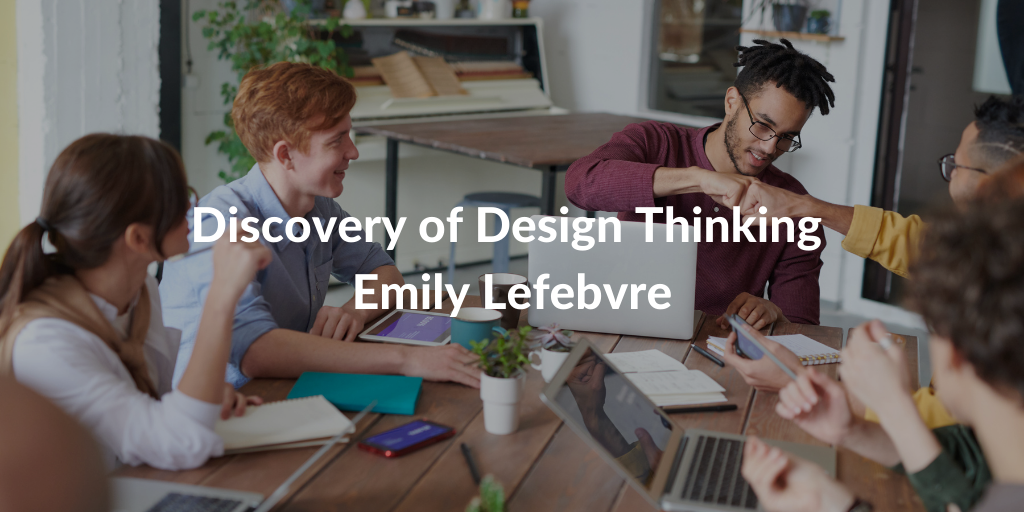What is your current role? What are your goals?
I am the founder of the Emy Digital organisation and at the same time I work as a trainer. I work with QRP International, with a team of trainers and facilitators in Design Thinking and co-design.
Our mission is to democratize the way of thinking that is Design Thinking. Not only in the business world but also in the associative reality, both in public bodies and public authorities.
Nowadays, we are all involved in major transformations and the need to be Agile. Design Thinking allows you to answer questions about how to work better together, how to adapt quickly and how to implement solutions quickly. All while having a design mindset.
How did you discover Design Thinking?
I started working in a small family business, continued to the business management level and then worked for an international start-up that built call centers. I was lucky enough to participate in the dazzling growth of a small business. In a very short time it has grown immensely and there was a need to develop a training service.
Once I discovered UX Design and Design Thinking I realized I had found my profession. I understood why I asked myself a lot of questions and why I loved doing things my way rather than waiting for something to be imposed on me. I had already developed the right mindset without even knowing it.
Finally, I worked for Société Générale. I was passionate about my work but I lacked autonomy and I suffered from not being able to take the initiative. I made a balance of skills that brought out my entrepreneurial soul, my taste for challenge and my creativity. I followed a training course as a digital project manager at the Digital Campus Paris where I learned to code and studied webdesign, graphics, Adobe layout on the operational technical part, web marketing, digital strategy, social network management, website launch.
At the end of this journey I decided to create my personal digital agency for lawyers, in cooperation with others I met with the same mindset. Why lawyers? In 2015, a law was passed that authorizes lawyers to communicate. We therefore used UX Design to meet the needs of lawyers: listen to them, become aware of their problems and thus created a particular offer to meet their needs. I realized that the area in which they needed the most was that of training.
I was then contacted by the Digital Campus Paris school to start training in UX Design and I became a trainer in several schools. During these trainings I managed to organize design challenges for the students to work in the design sprint.
In collaboration with QRP International we have now created a two-day course on the awareness of the Design Thinking method. Recently, the training can also be followed at a distance thanks to collaborative platforms such as zoom and others, which allow us to create our own templates and offer a quality of training at the same level as face-to-face training.
What is Design Thinking?
Design Thinking has been around for a long time but it is the IDEO design agency that developed a new way of solving problems and popularized the Design Thinking method in the 2000s.
This approach, born in Anglo-Saxon countries, is taken from design and is applicable to all company issues, regardless of the sector. Its principle? Use the design tools to solve any type of problem, from project management to the development of a product, service or organisation.
In other words, it is an experimental method of solving problems through empathy and collaboration. It takes the user’s needs into account and integrates them into the design process, working by iteration (experimentation, test and learn).
The heart of the Design Thinking approach is to bring a group of individuals to a maximum of different ideas and perspectives to achieve various possibilities of solutions to a given problem. It is this creative approach that makes it possible to find innovations. Design Thinking allows ideas to emerge based on collective intelligence thanks to experimentation with users.
Design Thinking is a methodology for solving problems. If the solution is validated, tested by users, it can be distributed thus entering the project / product management area. One can, for example, implement the solution such as launching the development of a software, an application, the architecture of a space (for example the new campus of a school, the covid service of a hospital), after having validated the concept at users following the double diamond process of Design Thinking.
How would you explain Design thinking in the simplest way?
Design Thinking is a modern way of working that passes through action and in which everyone is responsible at their own level, in the way that suits them to work or produce. There is no longer any separation between the hierarchical levels, which have been replaced by a spirit of collaboration, mutual help and collaboration to find a solution together. The people who decide are inspired by the people who are on the ground, that is, the recipients of the solution.
How far along is Europe in Design Thinking?
After 2014, Design Thinking has become a trend in French companies dealing with innovation. Organisations that were more mature or those that could afford to see things differently took a lot of interest. But at the time, design thinking was still perceived as something useful but not vital.
Today, with the crisis, Design Thinking has acquired great significance and companies have understood it very well. Especially in some business sectors, which constantly want to reinvent themselves and propose new offers, solutions, products and services.
We talk about Design Thinking but we can equally talk about co-design, collective intelligence, managerial innovation, UX Design and Agility. These trends were already present following the changes brought about by the digital transformation, to which it was necessary to adapt and the effects were repeated and amplified with the health crisis.
Design Thinking is a method that has great potential and there is still a lot of leeway before all companies are aware of it and are able to use it every day.
What are the reasons for this success? What benefits can this method bring to an organisation?
Mainly Design Thinking is a trend, it allows you to solve problems within a limited timeframe and to put teams to the test. It allows you to collect and test solutions and be agile and resilient at the same time.
More than a method, Design Thinking is a state of mind, born first of all from positive thinking, sharing, and the ability to bounce on the ideas of others, to build together rather than being against each other.
Using Design Thinking allows you to gain a considerable amount of time. Thanks to the method, the team arrives more quickly at a solution that really meets the needs of the users and avoids developing an ineffective or unsuitable solution.
Design Thinking allows you to work by iteration, “test and learn”, so as to be able to continuously check if the solution is convenient for the user and to adapt and modify it according to his continuous feedback. In this way, the user has a central position in the conception of new projects.
Design Thinking allows you to solve complex problems, identify opportunities for innovation and propose innovative solutions. It also allows you to develop some essential skills: the capacity for empathy, collaboration, collective intelligence, creativity and Agility. Putting this method into practice with your own theme will allow you to strengthen collaboration and cohesion between members.
“Alone we go faster, together we go further”.
What are the ‘traps’ to avoid?
To believe that Design Thinking is a miraculous recipe and to think that all solutions are served on a silver platter. You have to be ready for change, ready to get involved and let go. Working with the Design Thinking methodology requires support for changing teams.
What are the skills you would like to deepen in the near future to continue to grow professionally?
First of all, I would like to deepen my knowledge on prototyping (service prototype). I am also curious about circular design, in order to think of solutions that are more durable and responsible.









